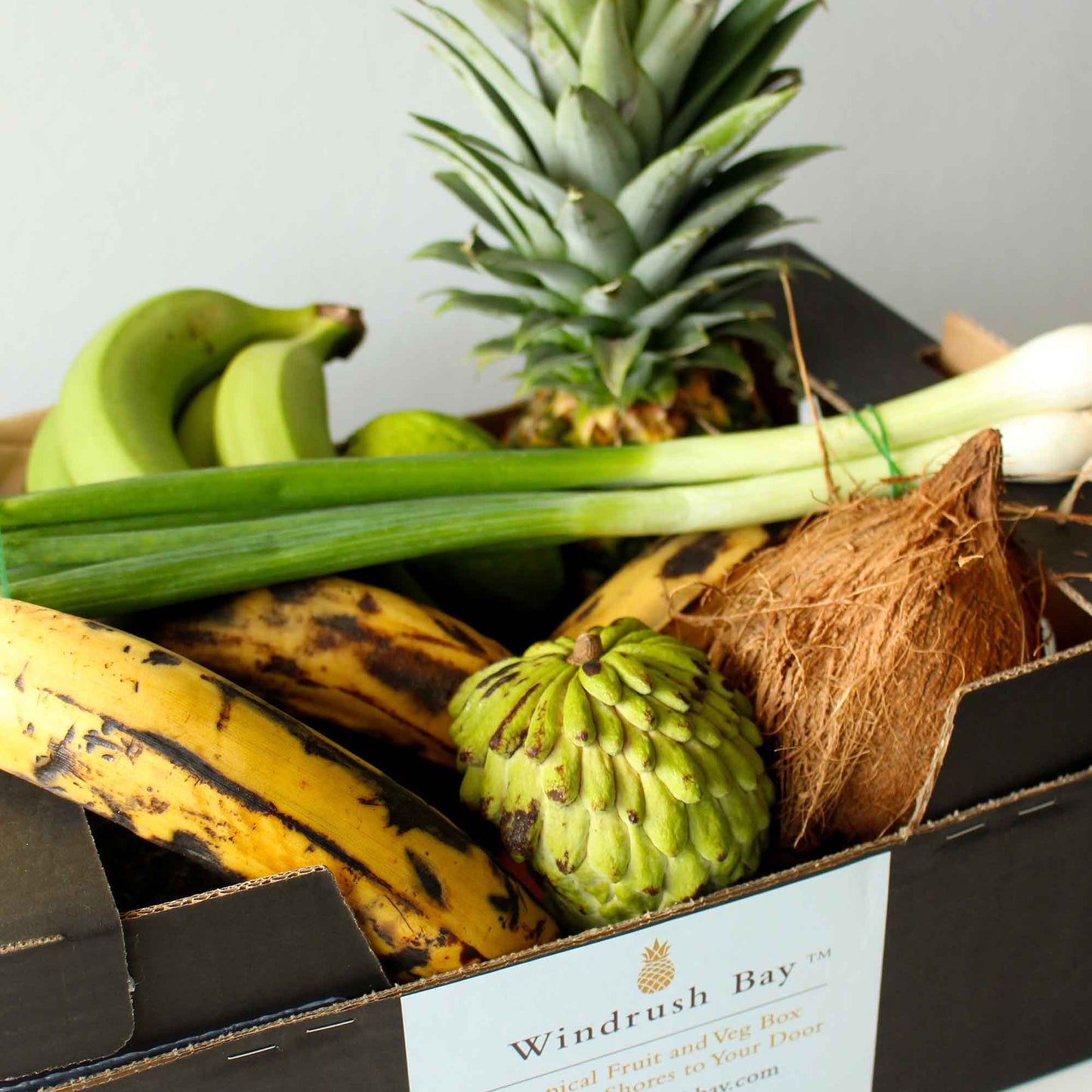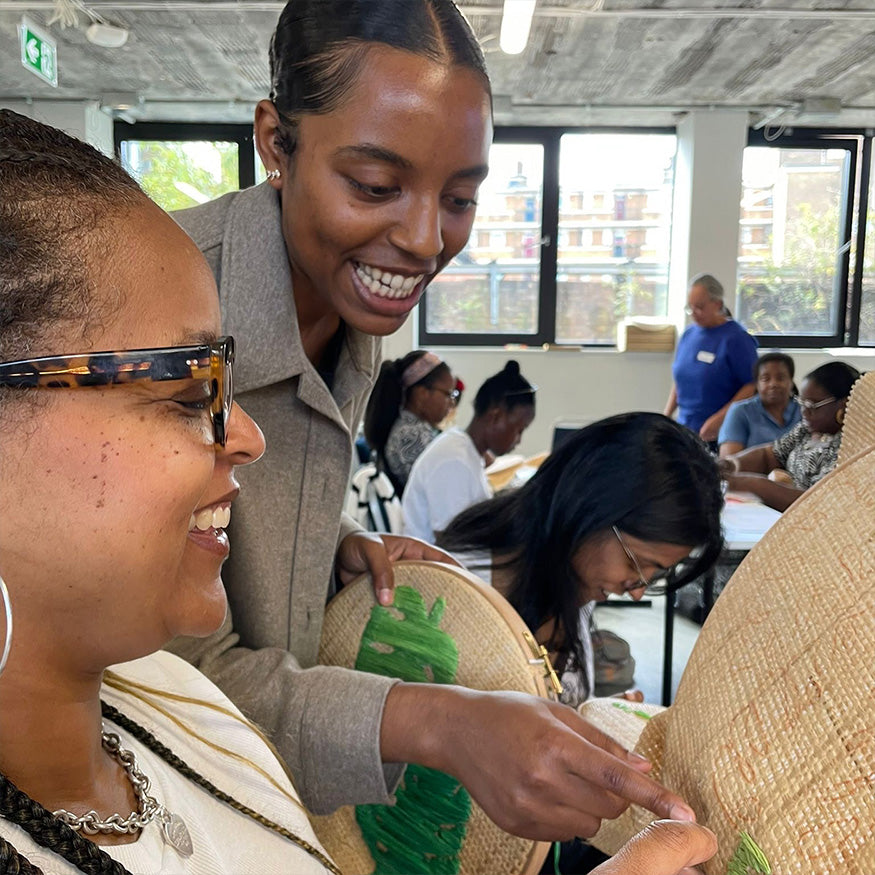Get 10% off with code:

The Caribbean is a region renowned for its vibrant culture, stunning beaches, and delicious cuisine. One of the most exciting aspects of Caribbean food is the incredible variety of fruits and vegetables that grow in the region's tropical climate. From ackee to yam, there are so many unique and delicious ingredients to discover. In this guide, we'll take a closer look at some of the most popular and interesting produce that you can find in the Caribbean. We'll explore their taste, texture, interesting facts about them, and their culinary uses, so you can enjoy these ingredients in your own kitchen. Whether you're a foodie looking to expand your culinary horizons or simply curious about the fruits and vegetables that grow in this beautiful part of the world, this guide will take you on a mouth-watering journey through the diverse and delicious produce of the Caribbean.
Caribbean Agriculture
The Caribbean region is characteristically warm, sunny and humid throughout the year, a favourable climate for agriculture. The history of agriculture in the Caribbean is a long and complex one that spans hundreds of years. The indigenous peoples of the Caribbean, including the Tainos and Caribs were highly developed agricultural people who cultivated a wide range of crops, including cassava and sweet potatoes. The arrival of European colonisers in the 15th century, introduced new crops and farming techniques. Sugarcane became a highly profitable crop (as well as many others) in the Caribbean which led to the establishment of large-scale plantations and the enslavement of millions of Africans. Other crops produced through the transatlantic slave trade included goods such as sugar, coffee, tobacco and cotton. Learn more about the history of the transatlantic slave trade here.
Despite the many challenges and injustices faced in Caribbean agriculture over the centuries, it remains an important part of the region's economy and culture. Agriculture is a key source of employment in many Caribbean countries, accounting for approximately 16% of the overall employment in the region (see sources and further reading). Today, the Caribbean is home to a diverse array of crops, including fruits, vegetables and spices. These crops not only provide for the people of the region but also contribute to the global food market and help to shape the identity and heritage of the Caribbean.
List of Caribbean Fruits & Vegetables
Explore this list of some of fruits and vegetables that grow in the Caribbean and is used in Caribbean cooking.
Ackee
Ackee is the national fruit of Jamaica and is most well known as one of the main ingredients in the dish ‘Ackee & Saltfish’. Ackee is technically a fruit, but it's cooked and used as a vegetable (similar to tomatoes). Ackee grows on evergreen trees that are native to West Africa, and is available throughout the year. When ripe the fruit is bright red and splits open exposing large black seeds and yellow-ish cream pulpy flesh. But be careful - the fruit is poisonous if not harvested and prepared properly.


Taste
Ackee has a unique flavour that’s hard to describe to people who have never tried it. It is sometimes described as creamy and nutty. Although it’s a fruit, it’s also described to have a starchy, savoury type of flavour. When cooked, ackee resembles scrambled eggs with its pale yellow colour and creamy delicate texture.
Cooking
In Jamaica, it is usually served with saltfish (salted cod), onions, tomatoes and more seasonings in the popular Jamaican dish Ackee & Saltfish which is often enjoyed for breakfast. It’s also served with plantain, dumplings, green bananas and callaloo. NOTE: be sure that the fruit is harvested and cooked properly because it contains toxins that can cause sickness if not.
Breadfruit
Breadfruit is a distinctive large starchy fruit with a rough surface. It is a very popular fruit tree in the Caribbean. Although it’s valued for its fruit, other parts of the tree are used for boat building and medicinal purposes. The tree was introduced to the region from Tahiti in the 18th century.

Taste
Breadfruit is described as having mild flavour that is often described as similar to potatoes or bread, but with a slightly nutty taste. When it is underripe it is starchy and best used in savoury dishes. As the fruit ripens, it softens and becomes sweeter.
Cooking
Breadfruit needs to be cooked to enjoy. Breadfruit can be boiled, fried, baked, grilled or roasted. In Jamaica, the whole breadfruit is often roasted until black and the skin peels back to expose the soft interior.
Callaloo
Callaloo is the name used for the leafy greens of a variety of plants, including taro (dasheen), tannia (malanga) and amaranth (prickly callaloo). It is also that name of a popular Caribbean vegetable dish. The callaloo dish made in each Caribbean country is different as they use different types of leaves, ingredients and methods.
Taste
The leafy greens used look similar to spinach in appearance, but the taste is not the same. Callaloo has a slightly bitter taste, that becomes milder when cooked, with a nutty undertone.
Cooking
The dish callaloo is usually steamed or sautéed. The leafy greens are the main ingredient, but other vegetables can be used like okra and scallion. The dish differs across the Caribbean, and other ingredient used can include sailfish, coconut milk, crab and pumpkin.
Cho-Cho
Cho-cho is also known as ‘christophene’ or ‘chayote’. It is a pear shaped squash that belongs to the gourd family. Although used similarly to a vegetable, it is actually a fruit. It is native to Mexico and Central America, but is now grown in many tropical and subtropical regions.

Taste
Cho-cho has a delicate flavour slightly sweet flavour. The taste could be described as a mix of apple and cucumber. It is also compared to the taste and texture of a young squash or marrow.
Cooking
Cho-cho is sometimes peeled before using. It can be used in salads, but also used in soups and stews.
Custard Apple
Custard apple is a green fruit with bumpy, leathery skin. It is also known as sweet sop, cherimoya and sugar apple. It gets the name custard apple from its creamy, sweet flesh.

Taste
Custard apples have a creamy texture and sweet taste. The taste can be compared to balance of a creamy banana, pineapple and mango.
Cooking
The flesh is usually eaten on its own discarding the seeds. However, it can also be used in a range of desserts, fruit salads, smoothies and ice-cream.
Guava
Guava is a small, round tropical fruit that is native to the Caribbean, Mexico and Central American. The skin is smooth and can be green, yellow or pink in colour.
Taste
It is a juicy fruit that has a sweet, tropical and tangy flavour.
Cooking
Guava is often eaten fresh or used in desserts. It is also used in jellies, jams and juices.
Guinep
Guinep is a small round tropical fruit with green outer skin that grows throughout the Caribbean region. It is also known as Spanish lime, mamoncillo, genip or ackee.
Taste
f you break open the skin when ripe, you will find a single seed surrounded by light orange pulp. The taste of guinep can be compared to a lychee fruit balanced with a sweet lime.
Cooking
Guinep is mostly eaten fresh. To eat, you can bite into the green skin to break it, and suck on the seed to eat the pulp then remove the seed. However, it’s worth noting that the seed is also edible, it is sometimes roasted to eat. Guineps are also used to make juice.
Golden Apple
Golden apple, also known as june plum, ambarella and kedondong, is a small, oval-shaped fruit. The skin of the fruit is thin and smooth, and it can be green, yellow, or orange. It is grown in many tropical and subtropical regions around the world, including the Caribbean, South America, and Africa.
Taste
The flesh of the fruit is white or yellow, and it is juicy and sweet. The flesh is crunchy and a more sour when unripe. It turns yellow or golden in colour when it’s ripe and has a more tropical fruity flavour likened to pineapple or mango. Each golden apple contains a single, large, hard, fibrous seed.
Cooking
It is eaten fresh and can be used in juices, jams, preserves, jellies and even chutneys.
Green Banana
A green banana is typically harvested when green and firm. Green bananas are known as a good source of potassium, vitamin C, and are said to be good for gut health. They are know as Caribbean figs in some parts of the Caribbean, and called guineos on Spanish speaking islands. Green fig & saltfish is the national dish of St Lucia.
Taste
Green bananas have a more savoury flavour and have a texture similar to potatoes once cooked.
Cooking
Green bananas are a popular ingredient in the Caribbean. They are mostly used as a vegetable in Caribbean cooking in savoury dishes. They can be boiled, mashed, fried, or baked. And can also be used to make porridge!
Nutmeg
Nutmeg is a tropical evergreen tree that is native Indonesia. The Caribbean is one of the world's leading producers of nutmeg. Grenada being the largest producer in the Caribbean. Grenada is known as the Spice Island and is responsible for over 20% of the world’s nutmeg production. The fruit is a round, fleshy capsule that contains a single nutmeg which is surrounded by lacy red covering called mace.

Taste
It has a warm, slightly sweet flavour with a hint of bitterness.
Cooking
Nutmeg is a popular spice that is used in a variety of both sweet and savoury dishes. Nutmeg is often used in baking and is a key ingredient in pies, cookies, and cakes. It is also used to spice savoury dishes like curries, soups, and stews. It is also sprinkled in a lot of drinks and cocktails.
Plantain
Plantains are a starchy, versatile fruit. A member of the banana family, they are believed to be native to Southeast Asia. Although they look similar to bananas, they are larger, have a thicker skin and are also more starchy. Plantains are a popular ingredient in the Caribbean, as well as in Africa and South America. Plantain is a versatile ingredient that can be enjoyed in both savoury and sweet dishes.

Taste
When plantains are green, they are firmer and more starchy. The taste may be described as more ‘bland’ at this stage. As they ripen, they turn yellow and then black - the riper the plantain, the sweeter it will be. Medium-ripe plantains are yellow or yellow with black spots, and they are slightly more sweet. When the skin has turned almost completely black, the plantains are fully ripe, very sweet and aromatic.
Cooking
Plantains are not eaten raw. Green plantains are often used more in savoury dishes like soups, stews, and curries. They can also be fried. Yellow plantains are also used in savoury dishes, but are also used in sweet dishes like pies, puddings, and fritters. Black plantains are the sweetest are more often used to make desserts, such as banana bread and plantain pudding. Plantain can also be boiled, baked, or roasted.
Scotch Bonnet
Scotch bonnet is a chilli pepper that very often use in Caribbean cooking to give dishes a hot, distinctive flavour. Scotch bonnets are small, irregular, flattened shaped peppers that can range in colour from green to yellow to orange to red and have a thick, waxy skin.

Taste
Scotch bonnets are very hot! They have a Scoville heat rating of 100,000-350,000 scoville units, ranking side-by-side with the habanero. This makes them one of the hottest chilli peppers available. However, they also have their own unique sweet flavour underlying the heat.
Cooking
Scotch bonnets are a popular ingredient in Caribbean food. They are often used in popular dishes like jerk chicken and curry goat. Scotch bonnets are also used to make hot sauce, pepper jelly, and other condiments. When using in soups and stews, the scotch bonnet can be used whole to impart its flavour without the full impact of its heat. Other times, it's simply chopped or minced and used to season food. The heat from the scotch bonnet can be reduced by removing its seeds and the inner membrane. Be sure to take care when you're chopping the pepper as you may feel a burning sensation when it comes into contact with skin, and definitely do not to touch your eyes or mouth! It’s recommended to wear cooking gloves when using.
Star Fruit
Star fruit (also known as carambola) is a tropical fruit that is native to Southeast Asia. Star fruit is a star-shaped fruit that has a has a thin, smooth skin, ranging in colour from green to yellow to orange.
Taste
The flesh of the star fruit is juicy, firm and crunchy, similar to an apple. It has slightly tart citrus flavour. The taste has been described as similar to a mix of pear, apple, grapes and citrus fruits.
Cooking
Star fruit fruits are usually ripe when they are yellow or orange and smell sweet. Star fruit can be eaten fresh, used in juices, jams, and jellies, or cooked in pies and other desserts. Their distinctive and beautiful shape make them perfect for decorating desserts, like pavlovas, cakes or fruit salad. NOTE: People with kidney problems should avoid star fruit. Ask a healthcare professional for more details.
Yam
Caribbean yams are a starchy root vegetable. There are many varieties, varying in size, shape and colour. Most commonly used are the ones with yellow and white flesh. The skin is tree bark like, and can feel rough or smooth.

Taste
Yams have a bland, starchy and nutty flavour. In cooking they are treated similar to potatoes.
Cooking
Caribbean yams are a popular ingredient in Caribbean cooking. They are often used in stews, soups, and curries. They can also be boiled, mashed, or fried. They can event be used to make a sweet yam pudding.
Where to find Caribbean fruits and vegetables
Most Caribbean fruits and vegetables can be found in local Caribbean supermarkets, market stalls or in specialty stores usually found in cities like London. Some can also be found in larger supermarkets.
However, one of the easiest ways to find Caribbean produce and groceries is online with Windrush Bay!
About Windrush Bay
Windrush Bay is an online Caribbean grocery shop. It was founded by Joanne Crossley, a passionate lover of all things Caribbean. She was inspired by the Windrush generation, the pioneers who came to the UK from the Caribbean after the Second World War, bringing their vibrant culture and cuisine with them. Windrush Bay was created out of a need for an alternative and more pleasant shopping experience for people who wanted to buy Caribbean products. Windrush Bay showcases the best and most authentic Caribbean brands, and offers a convenient delivery service to their customers so you can get your Caribbean products delivered to your door.
We are excited to be collaborating with Windrush Bay again, and pleased to offer our readers 15% off Windrush Bay Tropical Fruit & Veg Boxes*. To redeem your discount, just use code W75 at checkout on the Windrush Bay website.
*Offer valid on the Windrush Bay website. Offer ends 31st August 2023. Minimum spend of £15.
Sources and Further Reading
1. Strengthening Sustainable Agriculture in the Caribbean. Read more
2. The Indigenous Caribbean People. Read more
3. The Archaeology of Slavery. Read more
4. What is Ackee Fruit? Read more
5. What is Ackee and What Does it Taste Like? Read more
6. About Breadfruit. Read more
7. Breadfruit. Read more
8. Callaloo: The Caribbean vegetable. Read more
9. Chayote. Read more
10. Benefits of chayote. Read more
11. Benefits of Cherimoya. Read more
12. Guavas. Read more
13. Jamaican Guinep Fruit. Read more
14. June Plum or Golden Apple. Read more
15. Nutmeg: Grenada's Black Gold. Read more
16. Introduction to Plantains. Read more
17. What is a scotch bonnet chilli pepper? Read more
18. Caribbean scotch bonnet is so hot. Read more
19. Carambola. Read more
20. Star Fruit 101. Read more
21. Photo by Hamman Mohamed on Unsplash
22. Photo by ossama safi on Unsplash







